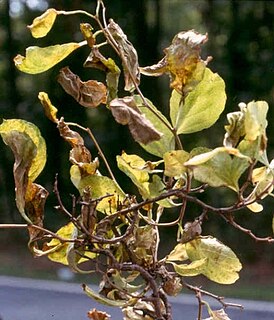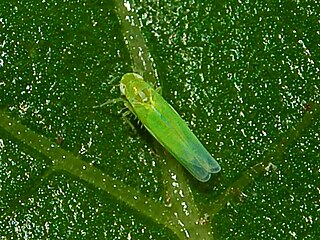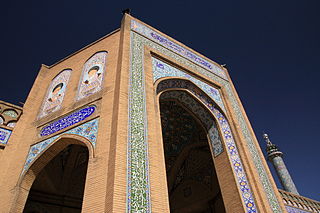
Kermanshah Province is one of the 31 provinces of Iran. The province was known from 1969 to 1986 as Kermanshahan and from 1986 to 1995 as Bakhtaran. According to a 2014 segmentation by the Ministry of Interior it is center of Region 4, with the region's central secretariat located at the province's capital city, Kermanshah. A majority of people in Kermanshah Province are Shia, and there are Sunni and Yarsani minority groups.

Kermanshah, also known as Kermashan, is the capital of Kermanshah Province, located 525 kilometres from Tehran in the western part of Iran. According to the 2016 census, its population is 946,681. A majority of the people of Kermanshah are bilingual in Southern Kurdish and Persian, and the city is the largest Kurdish-speaking city in Iran. Kermanshah has a moderate and mountainous climate. Most of the inhabitants of Kermanshah are Shia Muslims, but there are also Sunni Muslims, Christians, and followers of Yarsanism.

A takyeh is a building where Shia Muslims gather to mourn Husayn's death in the month of Muharram. Such buildings are particularly found in Iran, where there are takyehs in almost every city. Tehran alone is said to have had up to 50 takyehs under the Qajar dynasty. Takyehs are usually designed with observable elements of Persian architecture. Takyehs would host ta'ziyeh performances.

A leafhopper is the common name for any species from the family Cicadellidae. These minute insects, colloquially known as hoppers, are plant feeders that suck plant sap from grass, shrubs, or trees. Their hind legs are modified for jumping, and are covered with hairs that facilitate the spreading of a secretion over their bodies that acts as a water repellent and carrier of pheromones. They undergo a partial metamorphosis, and have various host associations, varying from very generalized to very specific. Some species have a cosmopolitan distribution, or occur throughout the temperate and tropical regions. Some are pests or vectors of plant viruses and phytoplasmas. The family is distributed all over the world, and constitutes the second-largest hemipteran family, with at least 20,000 described species.

The Auchenorrhyncha suborder of the Hemiptera contains most of the familiar members of what was called the "Homoptera" – groups such as cicadas, leafhoppers, treehoppers, planthoppers, and spittlebugs. The aphids and scale insects are the other well-known "Homoptera", and they are in the suborder Sternorrhyncha.

Kermanshah County is located in Kermanshah province, Iran. The capital of the county is Kermanshah. At the 2006 census, the county's population was 950,400, in 235,408 families. A majority in Kermanshah are Shia Muslims, with minorities of Sunni Muslims and believers of Yarsanism.
Kermanshah Airport is an airport in Kermanshah, Iran. It serves the city of Kermanshah and the surrounding areas with daily domestic and seasonal international destinations. It is located in the eastern part of the city and shares its land with the Havanirooz 1st Combat Base.

Curly top is a viral disease that affects many crops. This disease causes plants to become smaller in size, have shriveled petals and leaves, and are twisted and pulled out of shape. They are often caused by curtoviruses, members of the virus family Geminiviridae. This disease is important in western United States, such as California, Utah, Washington, and Idaho.

Elm yellows is a plant disease of elm trees that is spread by leafhoppers or by root grafts. Elm yellows, also known as elm phloem necrosis, is very aggressive, with no known cure. Elm yellows occurs in the eastern United States, and southern Ontario in Canada. It is caused by phytoplasmas which infect the phloem of the tree. Similar phytoplasmas, also known confusingly as 'Elm yellows', also occur in Europe. Infection and death of the phloem effectively girdles the tree and stops the flow of water and nutrients. The disease affects both wild-growing and cultivated trees.

Graphocephala fennahi is a species of leafhopper native to the United States. Its common name derives from it feeding on the sap of rhododendrons. The species was introduced to Great Britain in the 1930s and continental Europe in the 1970s. There has been suggestion that the rhododendron leafhopper contributes to the spread of a rhododendron fungus through Europe.

USS Kermanshah (ID-1473) was a cargo ship that served in the United States Navy from 1918 to 1919.

Deltocephalinae is a subfamily of leafhoppers. Deltocephalinae is the largest subfamily in the family Cicadellidae and is divided into 40 tribes, comprising over 925 genera, and over 6,700 described species.

Empoasca decipiens is a species of leafhopper belonging to the family Cicadellidae subfamily Typhlocybinae. The adults reach 3–4 millimetres (0.12–0.16 in) of length and a are homogenously green with whitish markings on its pronotum and vertex. E. decipiens is commonly referred to as the “green leafhopper” because of its colouration. The absence of clear stripes along the forewings can easily distinguish it from the similar leafhopper species E. vitis, but distinguishing it from other leafhoppers with the same colouration requires examination under a microscope. It is present in most of Europe, in the eastern Palearctic realm, in North Africa, in the Near East, and in the Afrotropical realm. Both nymphs and adults of this small insect are considered to be a very destructive pests on field crops, vegetables and greenhouse plants.
Burbur is a village in Sanjabi Rural District, Kuzaran District, Kermanshah County, Kermanshah Province, Iran. At the 2006 census, its population was 320, in 68 families. The village is on the road to Kermanshah, about 45 km away
Choqa Kabud is a village in Chaqa Narges Rural District, Mahidasht District, Kermanshah County, Kermanshah Province, Iran. During the 2006 census, its population was 222, in 45 families. The village is located some 282 miles (454 km) west of Tehran.

The Jameh Mosque of Kermanshah, also called the Chehel Sotoun mosque, is located in the old City of Kermanshah, on Modarres Street, to Rashid Yasemi Street.

Jameh Mosque of Shafei is located in the city of Kermanshah, which is located on the Bazaar of Kermanshah.
Shahin Kermanshah Futsal Club is an Iranian professional futsal club based in Kermanshah.
Arboridia is a genus of true bugs belonging to the family Cicadellidae.
Anagrus atomus is a species of fairyfly. It is an egg parasitoid of Arboridia kermanshah, the grape leafhopper.












